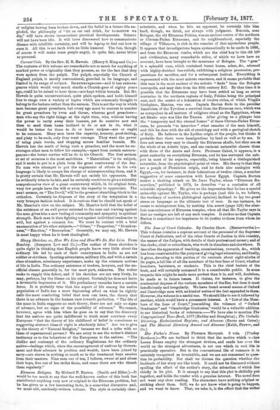Etruscan Bologna. By Richard F. Barton. (Smith and Elder.)—It would
be too much to say that the well-known author of this book has contributed anything very new or original to the Etruscan problem, but he has given us a few interesting facts, in a somewhat discursive and, we mast add, carelessly-written volume. The style is certainly char-
acteristic, and when ho hits an opponent, he certainly hits him hard, though, we think, not always with judgment. Bononia, near Bologna, the old Etrnscan Felsina, was an ancient centre of the northern or Circum-Padan Etrascans, and its neighbourhood, especially the village of Villanova, is rich in the remains of that mysterious people. It appears that investigations began systematically to be made in 1856, and from the Etruscan tombs, which are the chief key to this old life and civilisation, many remarkable relics, of which we have here an account, have been brought to the museums of Bologna. The "gem" is a splendid vase, which contained burnt bones, ashes, &c., adorned with highly-finished bas-reliefs, exhibiting a religions procession, pre- parations for sacrifice, and for a subsequent festival. Everything is represented with the most minute exactness, and it seems probable that this vase is the most ancient of the artistic "finds" from the Bologna necropolis, and may date from the fifth century B.C. By that time it is possible that the Etruscans may have been settled as long as seven centuries in the northern regions of Italy, Felsina being the principal seat, and the centre of a federation of twelve cities, of which Virgil's birthplace, Mantna, was one. Captain Burton finds in the peculiar fanaticism of the Tyrolese a survival from the Etruscan race, which was as scrupulous in all matters of religious ritual as the Egyptians, whose art Strabo says was like the Tuscan. After giving us a glimpse into the "temporary and the eternal homes" of these Circum-Padan Etrus- cans, he proceeds "to interview" what remains of the man himself, and this he does with the aid of craniology and with a geological sketch of Italy. He believes in the Lydian origin of the people, but thinks it probable that there were immigrations by land as well as by sea. It does not seem very easy to classify the Etruscan skulls, but they are on the whole of an Asiatic type, and one eminent naturalist classes them with those of the Arabs and Jews. Professor Calori, it appears, is a great authority on everything Etruscan, and he has surveyed the sub- ject in most of its aspects, especially, being himself a distinguished naturalist, from the physiological point of view. His theory is that they are a people of Phcenician origin, and he finds also analogies with Egypt,—as, for instance, in their federations of twelve cities, a number suggestive of some connection with Lower Egypt. Captain Burton makes a slashing attack on Mr. Isaac Taylor, whose "Etruscan Re- searches," published in 1874, he describes " as a confusion of all scientific etymology." Ho gives us the impression that he has a special animosity against Mr. Taylor, who is perhaps (and this is, we believe, the tendency of modern philological opinion) inclined to lay too great stress on language as the ultimate test of race. In one instance, he seems to misrepresent him, by making him assert (page 119) the abso- lute non-existence of Etruscan temples, when all that Mr. Taylor says is that no vestiges are left of any such temples. It strikes us that Captain Barton is sometimes too impetuous to do justice to those from whom he differs.


































 Previous page
Previous page